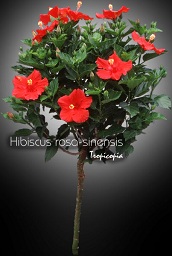Table of contents
Chinese hibiscus

Latin Name: Hibiscus rosa-sinensis
Category: Flower
Family: Malvaceae
Origin: Asia
Climate: Tropical
Growing Zones: 11-12
Care Instructions
The Chinese hibiscus (Hibiscus rosa-sinensis) is a tropical plant that originates from Asia. This flower plant belongs to the Malvaceae family and is well-suited for growing in USDA zones 11-12.
Complete Care Guide for Chinese Hibiscus (Hibiscus rosa-sinensis)
Watering Requirements
The Chinese hibiscus thrives in consistently moist soil, but it is crucial to avoid overwatering, which can lead to root rot. Water the plant deeply when the top inch of soil feels dry to the touch. During the growing season, typically from spring to early fall, the plant may require watering every 2-3 days, especially in hot weather. In winter, reduce watering frequency as the plant enters a dormant phase. Always ensure that the pot has good drainage to prevent water from pooling at the bottom.
Light Conditions
Chinese hibiscus prefers full sun to partial shade for optimal growth and flowering. Ideally, it should receive at least 6 hours of direct sunlight each day. If grown indoors, place it near a south-facing window where it can soak up the sun’s rays. Insufficient light can lead to leggy growth and fewer blooms. If you notice the leaves turning yellow or dropping, it may be a sign that the plant is not receiving enough light.
Soil Preferences
The ideal soil for Chinese hibiscus is well-draining, rich in organic matter. A mix of potting soil, peat moss, and perlite or sand works well to provide the necessary drainage and aeration. The pH level should be slightly acidic to neutral, around 6.0 to 7.0. Regular fertilization during the growing season is essential to promote healthy growth and vibrant blooms. Use a balanced, water-soluble fertilizer every 4-6 weeks, or opt for a slow-release fertilizer at the beginning of the growing season.
Pests and Diseases
Chinese hibiscus can be susceptible to various pests, including aphids, spider mites, and whiteflies. Regularly inspect the leaves for signs of infestation, such as sticky residue or webbing. If pests are detected, treat the plant with insecticidal soap or neem oil, ensuring to cover both the tops and undersides of the leaves. Additionally, watch for diseases like root rot and leaf spot, which can occur due to overwatering or poor air circulation. To prevent these issues, ensure proper watering practices and provide adequate spacing between plants for airflow.
Special Care Tips
To keep your Chinese hibiscus healthy and blooming, consider the following special care tips: Prune the plant regularly to encourage bushier growth and remove any dead or yellowing leaves. This not only improves the plant’s appearance but also helps prevent disease. If you live in a region with cold winters, consider bringing your hibiscus indoors or providing protection from frost. Additionally, during the blooming season, deadhead spent flowers to promote new blooms and maintain the plant’s vigor. Lastly, be mindful of humidity levels; if the air is too dry, especially indoors, mist the leaves occasionally to provide extra moisture.








